Moniek Bloks's Blog, page 189
February 17, 2020
The Year of Queen Wilhelmina – The life of Princess Christina
At the end of August 1946, after the Dutch royal family were all reunited in the Netherlands after the Second World War, a press release announced that Princess Juliana would have to limit her duties due to “happy circumstances.” She was pregnant for the fourth time, but she was worried about the pregnancy because she knew she had been infected with rubella.
Rubella can be fatal for a fetus, and if it survives, it can lead to blindness and deafness, among other things. On 18 February 1947, Princess Juliana gave birth to a daughter named Maria Christina (first known as Marijke and then as just Christina). Unfortunately, as Juliana had feared, Christina suffered from blindness in one eye and cataracts in the other eye. The news of her condition was announced a month after her birth. Juliana blamed herself, eventually leading to the introduction of the faith healer Greet Hofmans at court. Just one year later, Christina’s grandmother Queen Wilhelmina abdicated the throne in favour of Juliana and she now also had to bear the heavy burden of the crown.
Embed from Getty Images
Greet Hofmans later wrote of her young patient, “It is a sunny and brave child. She could see nothing and walked around on hearing. As a consequence, she bumped something and fell every other second. […] She knows me very well, and it is intensely moving to see a smile of recognition on her blind face.”1 The faith healer would be unable to heal her patient and was later banned from court.
Embed from Getty Images
Christina attended the social academy De Horst in Driebergen, and she also took classes at the University of Groningen. In 1968, she moved to Canada to follow singing and music classes at the École de musique Vincent-d’Indy in Montreal. She also attended McGill University. She eventually worked as a vocal pedagogue in New York, where she would meet her future husband – Jorge Guillermo, a Cuban exile. She often sang for her family during official events, such as the funerals of her parents and the wedding of her son Bernardo.
Embed from Getty Images
They were civilly married on 28 June 1975 in Baarn, followed by a religious ceremony in Utrecht. Christina chose not to ask for permission to marry from parliament and subsequently forfeited her rights to the throne. They initially lived in New York before moving back to the Netherlands in 1984. They went on to have three children together: Bernardo Federico Tomás (born 17 June 1977), Nicolás Daniel Mauricio (born 6 July 1979) and Juliana Edenia Antonia (born 8 October 1981). They finally settled in Villa Eikenhorst in Wassenaar. In 1992, Christina officially converted to Catholicism.
Her marriage to Jorge ended in divorce in 1994, and she settled in New York with her sons while her daughter went to live with her father in London. In New York, Christina was a vocal coach, and she recorded several albums. From 1989, she supported an annual competition held in the Netherlands to encourage musical talent in children, and it was named the Prinses Christina Concours for her. Christina was also a dance therapist who worked with dance and sound therapy with the blind.
Princess Christina singing at her father’s funeral
In 2018, Princess Christina was diagnosed with bone cancer, and she passed away at Noordeinde Palace on 16 August 2019 at the age of 72. She was the first of Queen Wilhelmina’s grandchildren to pass away. For what she had achieved despite her blindness, Christina was Juliana’s greatest pride. She had “made it all on her own” because of her “strong personality.”2
Embed from Getty Images
The post The Year of Queen Wilhelmina – The life of Princess Christina appeared first on History of Royal Women.
February 16, 2020
Abigail Kinoiki Kekaulike Kawānanakoa – The Hawaiian heiress
Abigail Kinoiki Kekaulike Kawānanakoa was born on 23 April 1926 as the daughter of Lydia Liliuokalani Kawānanakoa and William Jeremiah Ellerbrock. Her mother was the daughter of Prince David Kawānanakoa and Princess Abigail Campbell Kawānanakoa. She is the great-grandniece of the last Queen of Hawaii, Queen Liliʻuokalani, and as such, many consider her a possible heiress should the monarchy be reinstated. The monarchy was overthrown in 1893 and officially abolished two years later.
Thus, when Abigail was born, the monarchy was already a thing of the past. When Abigail was just six years old, she was officially adopted by her grandmother Princess Abigail Campbell Kawānanakoa so that she would be prioritised as a royal heir and as an heiress to the Campbell estates.1 Abigail would remain her parents’ only child and after they were divorced, her mother would go on to marry three more times. Her father does not appear to have remarried.
Abigail received her education from the Punahou School in Honolulu, the Shanghai American School in Shanghai from 1938 to 1939, and Notre Dame High School in California, from which she graduated in 1943. She then attended the Dominican College in California from 1943 to 1944 and studied at the University of Hawaii in 1945. Her grandmother passed away on 12 April 1945.
Abigail is known to be an expert horsewoman and breeder. She was awarded an honorary degree from the Colorado State University in 2016 for her support of the equine medicine program. She has also been active in preserving Hawaiian culture, including the restoration of the ‘Iolani Palace. As an heiress of the Campbell estate, her wealth is estimated to be at about $250 million.
Abigail married her partner Veronica Gail Worth – who is almost 30 years younger than her – on 1 October 2017. They have reportedly been partners for over 20 years.
The post Abigail Kinoiki Kekaulike Kawānanakoa – The Hawaiian heiress appeared first on History of Royal Women.
February 15, 2020
Female Heirs – Leonor, Princess of Asturias
With the introduction of absolute primogeniture in most European monarchies, there are now several Queens in waiting. With our new series Female Heirs, we’ll be taking a look at those young women who will one day rule in their own right.
Leonor, Princess of Asturias, was born on 31 October 2005 to then Prince and Princess of Asturias, now King Felipe VI of Spain and Queen Letizia. She was born during the reign of her grandfather, King Juan Carlos I. She was second in the line of succession at the time of her birth and is currently first in line. However, Spain still practises male-preference primogeniture and any subsequent son born to her father would displace her as the heir.
Embed from Getty Images
Leonor left the hospital with her parents on 7 November 2005, and her baptism took place in the Zarzuela Palace on 14 January 2006. Her full name is Leonor de Todos los Santos de Borbón y Ortiz. Her grandfather and grandmother, King Juan Carlos I and Queen Sofia, acted as her godparents. A younger sister Infanta Sofía was born in 2007.
Embed from Getty Images
Leonor’s education began at the Santa María de los Rosales Primary School, just outside Madrid. Her younger sister later also enrolled there. Leonor is already fluent in Spanish and English, and she has also studied Mandarin.
Since 2014, Leonor has slowly become more visible to the public. She made her first official visit in May 2014 to the San Javier Air Force Base in Murcia. Just a few months later, her grandfather abdicated the throne, and her father became the new King. Leonor, as the eldest daughter with no brothers, became the heiress presumptive and received the titles Princess of Asturias, Princess of Girona, Princess of Viana, Duchess of Montblanc, Countess of Cervera and Lady of Balaguer. In 2015, Leonor received First Communion.
Embed from Getty Images
On 30 October 2014 – the day before her 10th birthday – she was granted the Order of the Golden Fleece, and she was officially given the collar of the Golden Fleece in January 2018 to coincide with her father’s 50th birthday. She also received her own personal standard and guidon. In 2018, she went with her parents to celebrate the 1,300th anniversary of the Kingdom of Asturias, and on her 13th birthday, she gave her first public speech, where she read the first article of the Constitution of Spain. In 2019, she gave her first speech at the Princess of Girona Foundation, where she spoke in Spanish, Catalan, English and Arabic.
Embed from Getty Images
If Leonor succeeds her father as expected, she will be Spain’s first queen regnant since Queen Isabella II, who reigned from 1833 to 1868.
The post Female Heirs – Leonor, Princess of Asturias appeared first on History of Royal Women.
February 14, 2020
The Funeral of Catherine of Aragon & Peterborough Cathedral
In May 1534, Catherine of Aragon – who had been set aside by her husband King Henry VIII so he could marry Anne Boleyn – was moved for the final time. Her destination was Kimbolton in Huntingdonshire. She spent her days with her women, her confessor and her doctor. She continued with her needlework and her devotions.
She fell ill in the winter of 1535, but she appeared to have recovered. However, by late December, she relapsed, and her apothecary wrote, “She gets worse every hour.”1 On 2 January 1536, the Spanish ambassador Chapuys was allowed to see Catherine, and she thanked him for his services. She appeared to be a little better and managed to hold down some food. He later wrote, “After I had kissed hands she took occasion to thank me for the numerous services I had done her hitherto and the trouble I had taken to come and see her, a thing that she had very ardently desired, thinking that my coming would be salutary to her, and at all events, if it pleased God to take her, it could be a consolation to her to die under my guidance and not unprepared, like a beast. I gave her every hope, both of her health and otherwise, informing her of the offers the king had made to me of what houses she would, and to cause her to be paid the remainder of certain arrears, adding, for her further consolation, that the king was very sorry for her illness, and on this, I begged her to take heart and get well, if for no other consideration, because the union and peace of Christendom depended upon her life.”2
On the night of 6 January, she managed to prepare herself for the night, “without any help, [she] combed and tied her hair and dressed her head.”3 However, when she woke the following morning, she was clearly dying. When dawn broke, her confessor sang the office and Catherine took the sacrament. She then prayed and asked those around her to pray with her for her soul and that of Henry’s. She also received the last rites.
Before her death, she dictated one last letter to Henry:
“My most dear lord, king and husband, The hour of my death now drawing on, the tender love I owe you forceth me, my case being such, to commend myself to you, and to put you in remembrance with a few words of the health and safeguard of your soul which you ought to prefer before all worldly matters, and before the care and pampering of your body, for the which you have cast me into many calamities and yourself into many troubles. For my part, I pardon you everything, and I wish to devoutly pray to God that He will pardon you also. For the rest, I commend unto you our daughter Mary, beseeching you to be a good father unto her, as I have heretofore desired. I entreat you also, on behalf of my maids, to give them marriage portions, which is not much, they being but three. For all my other servants I solicit the wages due them, and a year more, lest they be unprovided for. Lastly, I make this vow, that mine eyes desire you above all things.”4
Catherine died in the arms of Maria de Salinas, who had come over with her from Spain and had forced her way into the castle when she heard Catherine was dying. Catherine passed away a little before 2 P.M. on 7 January.
Catherine had requested that she would be buried in the convent of the Observant Friars, but that wish was not honoured. Neither were the 500 masses she requested said for her soul nor was a pilgrimage made on her behalf to the shrine of Our Lady of Walsingham.
An autopsy was performed, and all her organs were “as sounds as possible except the heart”, which was “quite back and hideous, and even after he had washed it three times, it did not change colour.” This immediately led to rumours of her being poisoned, but after so many years, her actual cause of death cannot be established. After the autopsy, her body was handed over the embalmers, who disembowelled it and enclosed it in lead.
Thirty miles north of Kimbolton, preparations were being made to inter Catherine as the “Dowager Princess of Wales.” Torches were to be lit in all the towns through which her body would pass, there would be nine lights in the cathedral while her body was attended by three mutes, several noblemen and four knights to bear a canopy over the body. She was to lie under a pall but without a wooden effigy. The chief mourner was Henry’s niece, Frances Brandon – the daughter of Henry’s sister Mary. She was not to receive a place of honour and was instead buried far from the high altar and even Chapuys complained, “They could not have given her a less honourable place, as I am told by men acquainted with those matters.”5
Click to view slideshow.
Catherine’s funeral took place on 29 January 1536. Chapuys did not attend as he refused to attend a service where Catherine was not honoured as a Queen. Her daughter Mary was forbidden from attending. The funeral sermon was preached by John Hilsey. Four centuries later Queen Mary, the wife of King George V, gave orders that symbols of Queens were to be hung above Catherine’s grave and there are still two banners bearing the royal arms of England and Spain.6There is now also golden letterings denoting her as Queen of England and a black slab now covers the grave. This was placed there during Victorian era renovations of the cathedral.
Peterborough Cathedral still celebrates Catherine’s life every year with the Katherine of Aragon Festival.
The post The Funeral of Catherine of Aragon & Peterborough Cathedral appeared first on History of Royal Women.
February 13, 2020
Infanta Marie Anne of Portugal – A teacher of humanity
Infanta Marie Anne of Portugal was born on 13 July 1861 as the fifth daughter of the former Portuguese King Miguel I – who had been exiled in 1834 – and Princess Adelaide of Löwenstein-Wertheim-Rosenberg. She was born at Schloss Bronnbach in the Kingdom of Württemberg and was known for her great piety. She also liked to smoke cigars.
As early as 1884, the future Grand Duke Guillaume (William) IV of Luxembourg – then only the Hereditary Prince of Nassau – sought her hand in marriages and asked his father, Adolphe, for permission. However, Adolphe wanted to keep his line protestant, and Marie Anne was a devout Catholic. The relationship between father and son became strained, but Guillaume was willing to wait him out.
In 1890, Adolphe inherited the Grand Duchy of Luxembourg from King William III of the Netherlands, and now Guillaume could look towards becoming a Grand Duke as well. It now also became even more important for Guillaume to marry and father heirs – especially after his uncle Nicholas made an unequal marriage. Guillaume refused to consider any other bride, and Adolphe reluctantly consented to the match. The 41-year-old Guillaume was now free to marry Marie Anne and so they did on 21 June 1893 with the understanding that any daughters would be raised as Catholics and any sons as protestants.
The newlyweds made their home at Schloss Berg where their first child – Marie-Adélaïde – was born on 14 June 1894. She was quickly followed by five more daughters: Charlotte (born on 23 January 1896), Hilda (born on 15 February 1897), Antonia (born on 7 October 1899), Elisabeth (born on 7 March 1901 ) and Sophie (born on 14 February 1902). Marie Anne and Guillaume were unbothered by the fact that they only had daughters, unlike Adolphe.
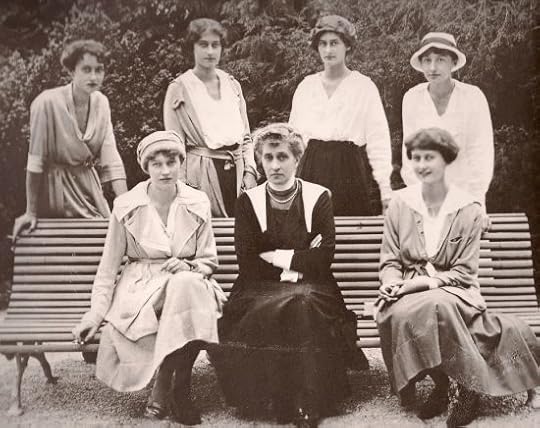 (public domain)
(public domain)Unfortunately, Guillaume was in rather poor health, and he had suffered a mild stroke in 1898. In 1902, he was appointed Lieutenant Representative on his father’s behalf and in 1905, Adolphe died, and Guillaume succeeded his father as Grand Duke. However, his ill health prevented him from reaching his full potential as Grand Duke. His stroke had left him with a brain embolism that causing increasing paralysis. In 1907, it was clear that Marie Anne would have no more children and Guillaume proclaimed succession rights for his daughters. The following year, Guillaume agreed to appoint his wife as regent as his health continued to deteriorate. Marie Anne feared the task before her, “but I must carry on for the Grand Duke’s sake. His intimate thoughts and feelings, which I know exactly, become my own.”
Marie Anne proved to be an excellent regent for her husband, but by 1910, Guillaume no longer recognised those around him, and he was completely dependent on others. In 1911, there was further bad news when a cancerous tumour was discovered in his throat, making it difficult for him to eat. He finally succumbed to his illnesses on 25 February 1912 with his wife and mother each holding one of his hands. Guillaume’s heir was his eldest daughter Marie-Adélaïde who was just a few months shy of her 18th birthday. Marie Anne continued to act as regent until her daughter’s 18th birthday.
The years of the First World War were difficult for Marie Anne as she had relatives on both sides of the conflict, and she refused to cut her ties to her German relations. During these years, she and her daughters all worked in military hospitals. One soldier would later recall, “Always when I think of it, with which Maria Anna and Marie Adelaide ensured our care… we lived in the illusion that we were being cared for by our own mothers, what wonderful teachers of humanity… we alone knew the work, which they carried out in the office of the field marshall.”
Marie Anne’s and Marie-Adélaïde’s pro-German stance during the war would cost them dearly. Marie-Adélaïde was forced to abdicate in favour of her younger sister Charlotte, while Marie Anne was asked to leave the Grand Duchy. Marie Anne took her four other daughters to Hohenburg, where she set up court. All four ended up marrying German princes. However, she did not like the Hohenzollerns and refused to let Crown Prince Wilhelm past her veranda when he came to call. She also despised the Nazis and once spat on a statue of Adolf Hitler which was being guarded by a soldier.
Embed from Getty Images
The Second World War forced Marie Anne to join her daughter Charlotte and her family in exile in the United States. While there, she was diagnosed with stomach cancer and underwent surgery. However, the disease had already spread, and Marie Anne died in exile on 31 July 1942. She was initially interred in St. Patrick’s Cathedral in New York City. Her body was brought back home in 1947, and she was buried beside her husband at the Notre-Dame Cathedral in Luxembourg city.1
The post Infanta Marie Anne of Portugal – A teacher of humanity appeared first on History of Royal Women.
February 12, 2020
Jacquetta of Luxembourg – Mother of the White Queen
Jacquetta of Luxembourg was born around 1416 as the daughter of Peter I of Luxembourg, Count of Saint-Pol, Conversano and Brienne, and his wife Margaret of Baux. She probably spent her childhood in the north of France, which was then part of England.
In 1422, King Henry V of England died and was succeeded by his nine-month-old son King Henry VI as King of England. The young King also became King of France a month later upon the death of his grandfather Charles VI of France and under the terms of the Treaty of Troyes. A long regency was now required by the King’s uncles – Humphrey, Duke of Gloucester in England, and John, Duke of Bedford in France. Jacquetta’s uncle Louis went on to serve John as his chancellor from 1425 until 1435.
Unfortunately, we know very little of Jacquetta’s early childhood. By the age of 14, she was part of marriage negotiations, and her marriage was arranged by her uncle Louis. The Duke of Bedford was in need of a new wife after his first wife, Anne of Burgundy, died in November 1432 of fever. Just five months later, the 43-year-old John married the 17-year-old Jacquetta at the bishop’s palace at Thérouanne. The timing was awkward, to say the least, and Anne’s brother the Duke of Burgundy was outraged that a year of mourning was not held.
Jacquetta now became the first lady of France, and they lived in the Hôtel de Bourbon, near the royal palace of the Louvre. Just two months after their wedding, Jacquetta travelled to England for the first time. They stayed in England for more than a year, but while there Jacquetta received the news that her father had died of the plague. He had only been Count of Luxembourg for three years. By July 1434, John wanted to return to France, and so they did – first staying in Paris before leaving for Rouen in early 1435. By then, John was already struggling with his health. From his deathbed, he appointed Sir Richard Woodville as lieutenant of Calais and as he lay dying, Richard and the soon-to-be widowed Jacquetta grew close. John, Duke of Bedford, died on 14 September 1435 and he was buried at Rouen.
Jacquetta had been left nearly everything in his will and was now a very wealthy 19-year-old widow. She and John had had no children together. However, she remained at the command of the King of England and King Henry VI sent for her to return to England. She was granted her dower on the condition that she did not marry without royal permission, but by then it may already have been too late. Jacquetta and Sir Richard travelled to England and confessed to having been married in late 1436 or early 1437. Jacquetta was ordered to pay a fine of £1,000, but the King forgave her. They were officially pardoned in October 1437, just in time for the birth of their first child Elizabeth. As was customary, Jacquette continued to be known as Duchess of Bedford. They went on to have at least 14 children, though their first son Lewis would die in childhood. Richard was often away as he continued to serve as deputy commander of Calais.
Shortly after Margaret of Anjou arrived in England as the new Queen, Jacquetta – who was related to her by marriage as her younger sister Isabelle had recently married Margaret’s uncle – became friends, and she became one of Margaret’s chief ladies-in-waiting. In 1448, Jacquetta’s husband was made Baron Rivers. By 1452, Jacquetta had arranged for the marriage of her eldest daughters to Sir John Grey. Jacquetta would find herself in a difficult situation in the coming years. As King Henry VI had periods where he was completely without speech or movement, Jacquetta stood by her Queen. Jacquetta was there when Margaret gave birth to her first and only child – Edward of Westminster. Once out of confinement, Margaret proposed herself as regent for the “sleeping” King, but she had very little support. Richard, Duke of York, was appointed as protector and defender of the Kingdom. After nearly a year and a half, King Henry VI recovered.
By 1455, the King was again ill, and Jacquetta probably left court to be with her daughter Elizabeth who was due to give birth to her first child. In 1457, Jacquetta’s husband was made constable of Rochester Castle, and they went to live there. The situation of King Henry VI spiralled out of control as different factions battled for power. A particularly terrifying episode saw Jacquetta, her husband and eldest son held in captivity. Richard, Duke of York, was eventually killed in battle and his claim was taken up by son Edward, Earl of March. Jacquetta’s eldest daughter Elizabeth was widowed by the events of the Second Battle of St Albans in 1461, and the ensuing Battle of Towton saw King Henry VI removed from the throne by Edward, who became King Edward IV.
Margaret and her son fled from York and Jacquetta, her husband and son probably left the city at once to return home. Jacquetta’s husband and son – who had fought for King Henry VI – were pardoned in July. Her daughter Elizabeth had difficulty receiving money from her mother-in-law, and so she returned home to parents with her two young sons where her family could argue her case to the King. In early 1464, Edward met the widowed Elizabeth and was so taken with her that they were married – in secret. It wasn’t revealed until September 1464, and the family saw a swift rise in their fortunes. As in-laws of the King, Jacquetta’s husband became Earl Rivers and their children made excellent marriages with the greatest nobles in the land.
Tragedy struck when Edward’s former ally the Earl of Warwick went rogue and captured Jacquetta’s husband and her son John, and they were beheaded side by side. Edward himself was also captured, and Jacquetta was also taken from her home to be charged with witchcraft. Jacquetta was formally tried, and witnesses were called of her supposed acts of witchcraft. In the end, she was not executed – perhaps due to her relationship with Margaret – but it was a scary time for her. Edward was eventually restored to the throne, but it was too late for Jacquetta’s husband and her son John.
In 1470, in another attempt by Margaret to regain the throne, Jacquetta, a pregnant Elizabeth and her three young daughters were forced to flee into sanctuary. In the crypt of a church, Elizabeth gave birth to a son named Edward. It wasn’t until after the Battles of Barnet and Tewkesbury that Edward was firmly back on the throne. Margaret’s son Edward was killed in battle, and King Henry VI was murdered shortly after. Margaret was eventually sent home to France as a poor relation of the King.
Jacquetta saw her son-in-law and daughter restored to the throne with a new generation to follow them. Jacquetta died on 30 May 1472 at the age of around 56 after what can only be described as an eventful life.1
The post Jacquetta of Luxembourg – Mother of the White Queen appeared first on History of Royal Women.
February 11, 2020
Lost Kingdoms: Kingdom of Lombardy–Venetia
The Kingdom of Lombardy–Venetia is one of the more short-lived Kingdoms in history. It was created in 1815 in recognition of Austria’s rights to Lombardy and the former Republic of Venice after the collapse of the Napoleonic Kingdom of Italy.
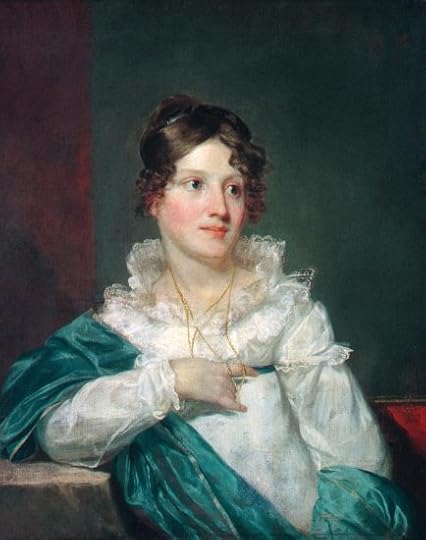 Maria Ludovika of Austria-Este (public domain)
Maria Ludovika of Austria-Este (public domain)The first King of the newly created Kingdom was Francis II, Holy Roman Emperor (later Francis I, Emperor of Austria). He was married four times, twice before the creation of the Kingdom. His first wife was Elisabeth of Württemberg who died in childbirth after just two years of marriage. His second wife was his double first cousin Maria Theresa of Naples and Sicily. They had twelve children together before she too died in childbirth. His third wife was his first cousin Maria Ludovika of Austria-Este, but she died eight years later without having had children. She died in 1816, one year after the creation of the Kingdom and was thus its first Queen. Francis’ fourth wife was Caroline Augusta of Bavaria, and the marriage lasted nearly 20 years but also remained childless.
When Francis died in 1835, he was succeeded by his eldest son, Ferdinand I. Ferdinand suffered from several health problems due to his parents’ close relationship. He married Maria Anna of Savoy, but they did not have any children together. Ferdinand abdicated in 1848, but the couple retained their Imperial rank. He was succeeded by his nephew, Emperor Franz Joseph I. He married his first cousin Elisabeth (known as Sisi) in 1854. She would turn out to be the last Queen of Lombardy-Venetia.
After the Second Italian War of Independence, followed by the defeat at the Battle of Solferino, parts of Lombardy had to be ceded to Emperor Napoleon IIII who passed it to the Kingdom of Sardinia. The remaining lands fell to the newly created Kingdom of Italy after the Austro-Prussian War.
The post Lost Kingdoms: Kingdom of Lombardy–Venetia appeared first on History of Royal Women.
February 10, 2020
Maria Amalia of Saxony – Queen of two nations
Maria Amalia of Saxony was born on 24 November 1724 as the daughter of Augustus III of Poland, Elector of Saxony and Maria Josepha of Austria.
In 1738, Maria Amalia became engaged to Charles, King of Naples and Sicily who would also become Charles III of Spain. Charles was the younger son of Philip V of Spain who became King of Naples and Sicily through conquest. This marriage sealed the peace between the Bourbons, the Habsburgs and Wettins. Her wedding to Charles would be the first royal wedding in Dresden since her parents’ 1719 wedding, which had lasted for a month. In order to show their dynastic connection, genealogists demonstrated that Charles and Maria Amalia had two great-great-great-grandfathers in common: Philip III of Spain and Johan Georg I, Elector of Saxony. Their genealogy was also traced right back to the great Charlemagne.
The proxy wedding took place on 9 May 1738 with her brother, Frederick Christian of Saxony, standing in for the groom. The week-long celebrations included two illuminations of the city (it had to be repeated due to bad weather), fountains of wine and an obelisk of rocks. On 13 May, Maria Amalia left the Palace of Pillnitz on the Elbe near Dresden. She was accompanied by her brother Frederick Christian, who would be seeking a cure for his weak legs on the island of Ischia in the Bay of Naples. Both she and her mother burst out in tears at her departure. Her train consisted of 200 people as befitting a Queen of Naples and Sicily. Her parents rushed ahead to have a surprise goodbye in private.
It took them 39 days, and they passed through three jurisdictions on the way. On 14 May, she reached Prague where she heard a Te Deum in the Cathedral on the Hradschin. She took a small detour towards St. Pölten to meet with her grandmother, Wilhelmina Amalia of Brunswick, Dowager Holy Roman Empress. She also visited the shrine of Mariazell before continuing to Venice, where she stayed overnight in Palmanova, Pordenone and Treviso. Each engagement required her to dress like a Queen, dripping with jewels. Finally, on 19 June, she arrived at the village of Portella on the border of the Kingdom of Naples, where her husband was waiting for her. They continued their travels together and arrived in Naples on 22 June. All the members of the household came to kiss her hand. On 2 July, they made their solemn entry into the city.
The couple was pleased with one another. Maria Amalia was still quite young and had not had her period yet. However, the marriage was consummated on 8 July 1738 with her husband writing to his parents that it took 15 minutes to break her hymen. Her husband proudly wrote to his parents on 20 November 1739 that she had had her first period and she soon fell pregnant with her first child. On 5 September 1740, she gave birth to her first child – a daughter named Maria Elisabetta. The King was reportedly “as happy about it as if it were a Prince.” She was nicknamed Isabelita. Her christening was celebrated with great pomp, but the little girl would tragically die in childhood. Four more daughters would follow: Maria Josefa (born 1742 – died young), Maria Isabel Ana (1743 – died young), Maria Josefa (born 1744) and Maria Luisa (born 1745). Their sixth child was finally the longed-for heir, Felipe Pascual was born on 13 June 1747. He would turn out to be mentally handicapped, and he had to be set aside in the succession. After the birth of their eldest son, she was admitted to the Council of State, though she had to listen to the deliberations from behind a curtain.
Seven more children would follow. The future Charles IV of Spain was born on 11 November 1748. Maria Theresa was born in 1749, but she died young. The future Ferdinand I of the Two Sicilies was born in 1751. Gabriel was born in 1752. Maria ana was born in 1754, but she died young. Antonio Pascual was born in 1755. Francisco Javier was born in 1757, but he died in childhood. He was to be their last child.
On 10 August 1759, Charles’ elder half-brother King Ferdinand VI of Spain died without leaving issue and so Charles also became King of Spain and Maria Amalia his Queen. With their eldest son excluded from the succession, their second-born son was designated as the heir of Spain, while the third son was designated as heir to Naples and Sicily.
The new King and Queen of Spain arrived with six of their children after a sea journey from Naples on 17 October 1759. They travelled on to Madrid where they arrived on 9 December 1759 with many of the family falling ill on the way. They made their solemn entry into Madrid on 13 July 1760. On 19 July, the acclamation and oath of fealty to Charles and his heir took place in the royal church of San Gerónimo.
Just two months later, on 27 September 1760, Maria Amalia died suddenly. Her health had deteriorated since her arrival in Spain. A fall from her horse probably also exacerbated things. She was still only 35 years old.1
The post Maria Amalia of Saxony – Queen of two nations appeared first on History of Royal Women.
February 9, 2020
King Chulalongkorn and his half-sister consorts
King Chulalongkorn of Siam (Thailand) was born on 20 September 1853 as the son of King Mongkut and Queen Debsirindra – his parents were great-uncle and great-niece and were 30 years apart in age. His mother died on 9 September 1862, and her sister continued to act as his father’s consort. Prince Chulalongkorn received a broad education – some of it was portrayed in the film Anna and the King. Chulalongkorn’s father, Mongkut, had at least 32 wives and concubines who gave him at least 82 children.
Mongkut died on 1 October 1868, and he was succeeded as King by Chulalongkorn. At the time, young Chulalongkorn was sick with malaria and was also believed to be dying, and so Mongkut ordered a new successor to be chosen who could “save the country.” Chulalongkorn survived the malaria attack, and his first coronation was held on 11 November 1868. Chulalongkorn would also become the father of many children – at least 77 by 92 consorts. His first child was born in 1867 before he became King.
Several of his consorts were also his half-sisters. These marriages were usually done to keep the bloodline pure and the power within the right family. It is perhaps no surprise that many of their children did not survive or if they did, their health was weak.
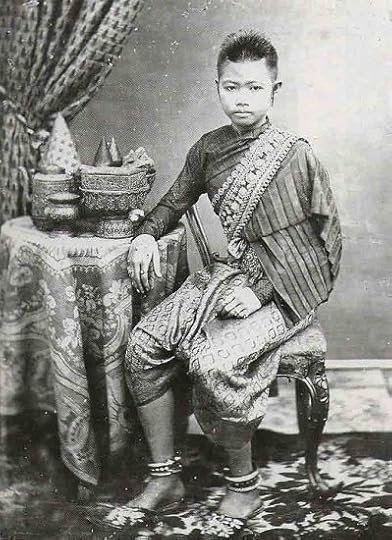 Daksinajar (public domain)
Daksinajar (public domain)Daksinajar Naradhirajbutri was born on 18 September 1852 as the daughter of King Mongkut and Chan Suksathit, a concubine. They had at least one son, but he lived for just eight hours and never received a name. The death of her son apparently distressed her so much that she felt unable to return to royal service. She died on 13 September 1906.
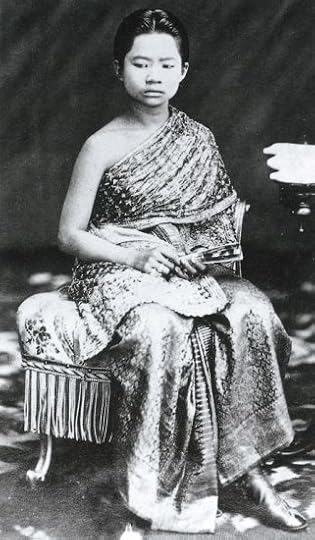 Sukhumala (public domain)
Sukhumala (public domain)Sukhumala Marasri was born on 10 May 1861 as the daughter of King Mongkut and Samli, a concubine. They had two children together, Princess Suddha Dibyaratana and Prince Paribatra Sukhumbandhu. She was known as Princess consort during her husband’s reign, but she was named Queen consort during her nephew’s reign. She died on 9 July 1927.
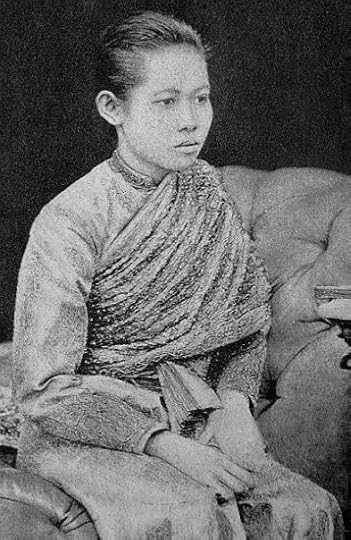 Savang Vadhana (public domain)
Savang Vadhana (public domain)Savang Vadhana was born on 10 September 1862 as the daughter of King Mongkut and Princess Piyamavadi. She married her half-brother sometime in 1877 and their marriage produced at least eight children. Her youngest daughter lived for just three days, and several other children did not live to adulthood. She would eventually outlive all of her children. Her youngest son Mahidol Adulyadej would become the father of Kings Ananda Mahidol and Bhumibol Adulyadej. She became known as the Queen Grandmother when her eldest grandson became King. She died on 17 December 1955 at the grand age of 93.
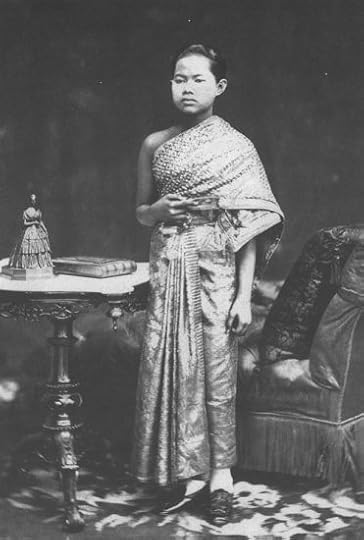 Sunanda Kumariratana (public domain)
Sunanda Kumariratana (public domain)Sunanda Kumariratana was born on 10 November 1860 as the daughter of King Mongkut and Princess Piyamavadi. She was thus the full sister of Savang Vadhana. She had one daughter with her brother, Princess Kannabhorn Bejaratana. Sunanda is mostly known for her tragic end. At the age of 19, while pregnant with her second child, Sunanda and her young daughter were by boat to the Bang Pa-In Royal Palace. The boat capsised, and the Queen and her daughter drowned because the bystanders were not allowed to touch royalty and were thus afraid to touch her. The incident took place on 31 May 1880. Her husband later erected a grand monument to them.
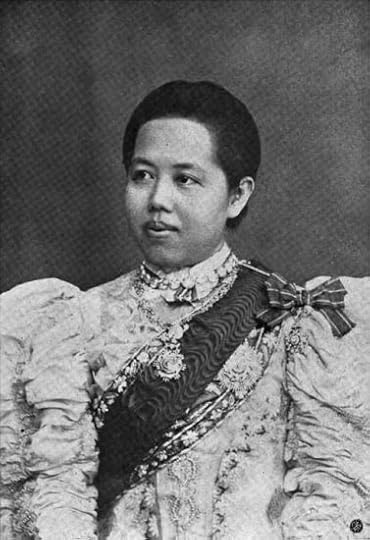 Sri Bajarindra (public domain)
Sri Bajarindra (public domain)Sri Bajarindra was born on 1 January 1864 as the daughter of King Mongkut and Princess Piyamavadi, making her the full sister of the two women above. She married her half-brother sometime in 1878. They would have nine children together, of which five would live to adulthood. Two of her sons would eventually succeed as King of Siam. In 1897, she acted as regent for her husband when he went on a tour of Europe, becoming the first woman to do so. She was especially interested in furthering women’s causes and was the founder of a girls school. She died on 20 October 1919 at the age of 55. Her son King Vajiravudh later stipulated that her children would have precedence in the line of succession, leading to the eventual succession of her youngest son Prajadhipok as King Rama VII.
The current King of Thailand (as Siam was renamed in 1939) is both Chulalongkorn’s great-grandson (through his father and Savang Vadhana – mentioned above) and his great-great-grandson (through his mother, Sirikit).
The post King Chulalongkorn and his half-sister consorts appeared first on History of Royal Women.
February 8, 2020
Is Lady Louise Windsor a Princess?
Following our Q&A “What makes a Princess and will Camilla be Queen?“, we answer another burning question. Is Lady Louise Windsor actually a Princess?
When Prince Edward married Sophie Rhys Jones in 1999, he was created Earl of Wessex1, and so upon marriage, Sophie became The Countess of Wessex. In a surprise move, it was also announced that any children they may have were to be styled as children of an Earl. Any daughters would be a Lady, while the eldest son would be “Viscount Severn” and any subsequent sons would be “The Honourable.”
However, according to the 1917 Letters Patent, any children of the monarch’s son, which Prince Edward is, are assigned princely status and the style of Royal Highness. So when their daughter Louise was born in 2003, she would actually be entitled to be called, “Her Royal Highness Princess Louise of Wessex” but per the earlier press release, she is referred to as “Lady Louise Windsor.” The 1917 Letters Patent are still in effect today, though it has been revised to include the children of the eldest son of the Prince of Wales (namely The Duke of Cambridge’s children, George, Charlotte and Louis).
Embed from Getty Images
It could be argued that a press release is not sufficient to counter a Letters Patent and therefore Louise is still legally entitled to call herself Princess Louise. In two years, she’ll be an adult, and with the recent changes among the senior members of the royal family, perhaps we could expect some changes ahead. But yes, Lady Louise is technically a Princess.
Embed from Getty Images
Do you have a question that you would like to submit to History of Royal Women? Email us at info@historyofroyalwomen.com or fill in our contact form here.
The post Is Lady Louise Windsor a Princess? appeared first on History of Royal Women.



